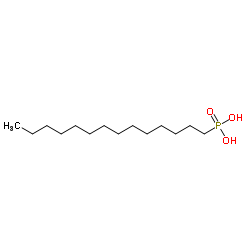Tetradecylphosphonic acid

Tetradecylphosphonic acid structure
|
Common Name | Tetradecylphosphonic acid | ||
|---|---|---|---|---|
| CAS Number | 4671-75-4 | Molecular Weight | 278.368 | |
| Density | 1.0±0.1 g/cm3 | Boiling Point | 411.2±28.0 °C at 760 mmHg | |
| Molecular Formula | C14H31O3P | Melting Point | 96-98ºC | |
| MSDS | USA | Flash Point | 202.5±24.0 °C | |
|
CdSe-graphene oxide light-harvesting assembly: size-dependent electron transfer and light energy conversion aspects.
ChemPhysChem 15(10) , 2129-35, (2014) Excited-state interaction between CdSe quantum dots (QDs) of different sizes (2.3, 3.2, and 4.2 nm diameter) and graphene oxide (GO) was probed by depositing them as films on conducting glass electrodes. The emission of smaller CdSe QDs (2.3 nm) was quenched ... |
|
|
Metal-Semiconductor Hybrid Aerogels: Evolution of Optoelectronic Properties in a Low-Dimensional CdSe/Ag Nanoparticle Assembly.
ACS Nano 9 , 9810-21, (2015) Hybrid nanomaterials composed of metal-semiconductor components exhibit unique properties in comparison to their individual counterparts, making them of great interest for optoelectronic applications. Theoretical and experimental studies suggest that interfac... |
|
|
Compact and blinking-suppressed quantum dots for single-particle tracking in live cells.
J. Phys. Chem. B 118(49) , 14140-7, (2014) Quantum dots (QDs) offer distinct advantages over organic dyes and fluorescent proteins for biological imaging applications because of their brightness, photostability, and tunability. However, a major limitation is that single QDs emit fluorescent light in a... |
|
|
Near-Room Temperature Synthesis of Core/Shell-Structured Quantum Dots.
J. Nanosci. Nanotechnol. 15 , 7146-52, (2015) Core/shell-structured quantum dots (QDs) are considered as important active materials for optoelectronic devices. There have been a lot of synthesis procedures developed so far. Real epitaxial growth of shell layer, however, has not been reported yet. Here, a... |
|
|
An Extended-gate Type Organic FET Based Biosensor for Detecting Biogenic Amines in Aqueous Solution.
Anal. Sci. 31 , 721-4, (2015) This study is the first to report on the detection of biogenic amines in an aqueous solution using an organic field-effect transistor (OFET) device with an extended gate electrode modified with a layer of diamine oxidase and a horseradish peroxidase osmium-re... |
|
|
Enhanced electrochemical methanation of carbon dioxide with a dispersible nanoscale copper catalyst.
J. Am. Chem. Soc. 136(38) , 13319-25, (2014) Although the vast majority of hydrocarbon fuels and products are presently derived from petroleum, there is much interest in the development of routes for synthesizing these same products by hydrogenating CO2. The simplest hydrocarbon target is methane, which... |
|
|
Synergistic geometric and electronic effects for electrochemical reduction of carbon dioxide using gold-copper bimetallic nanoparticles.
Nat. Commun. 5 , 4948, (2014) Highly efficient and selective electrochemical reduction of carbon dioxide represents one of the biggest scientific challenges in artificial photosynthesis, where carbon dioxide and water are converted into chemical fuels from solar energy. However, our funda... |
|
|
Synthesis, structure-activity relationships, and biological evaluation of fatty alcohol phosphates as lysophosphatidic acid receptor ligands, activators of PPARgamma, and inhibitors of autotaxin.
J. Med. Chem. 48 , 4919-30, (2005) We previously reported that fatty alcohol phosphates (FAP) represent a minimal pharmacophore required to interact with lysophosphatidic acid (LPA) receptors. To improve the activity of the first-generation saturated FAP series, a structure-activity relationsh... |